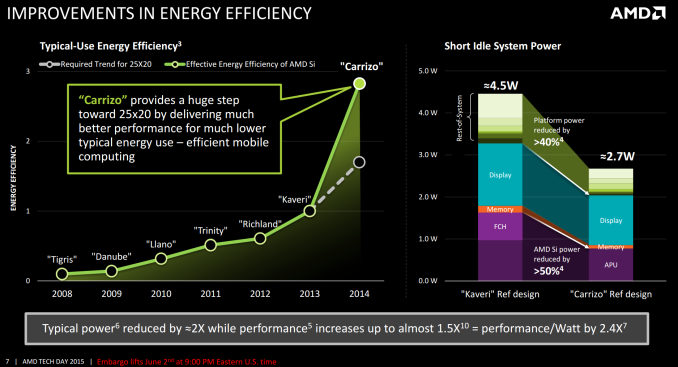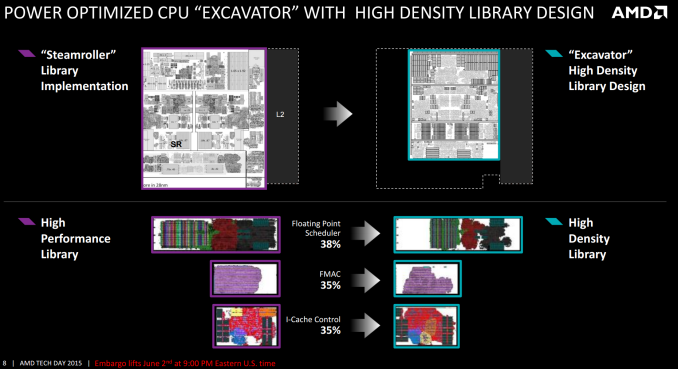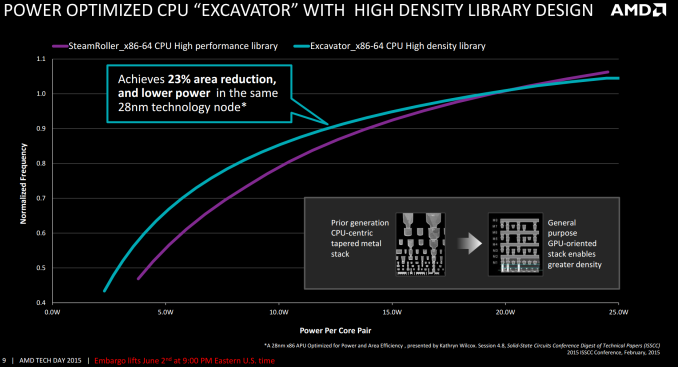AMD Launches Carrizo: The Laptop Leap of Efficiency and Architecture Updates
by Ian Cutress on June 2, 2015 9:00 PM ESTEfficiency and Die Area Savings
AMD’s take home message in all of this is efficiency. We a being quoted a performance per watt increase of 2.4x, coming from typical power draw savings of 2x and performance increase of almost 1.5x for 23% less die area, all in one go.
Ultimately this all helps AMD’s plan to be 25x more efficient with their APUs by 2020, and the cumulative bar chart on the right is how mobile improvements from all sides are being realized. Migrating the southbridge on die severely reduces its idle power consumption to almost zero and can help efficiencies elsewhere in the system. The APU general use and memory controllers are the next targets, but the common constant here is the display. Using a low power display might give battery life in exchange for quality, and there is only so much power you can save at the SoC level. In time, the display will be the main focus of power saving for these devices.
A big part of the reduction in die area comes from the set of high density libraries being used by AMD. Above were three examples provided where >33% gains were made in silicon area. Typically using a high density library design is a double edged sword – it reduces die area and potentially leaves more area for other things, but the caveat is that it may be more prone to defects in construction, require additional latency or have a different frequency/voltage profile. AMD assures us that these changes are at least like-for-like but most of them contain other improvements as well.
It’s worth noting here that AMD has described the high density library project internally as the equivalent of a moonshot, essentially the developers were part of a ‘skunkworks’ division attempting to make drastic changes in order to improve performance. The high density library is one such successful project from that.
With the new libraries, comparing Excavator to Steamroller shows the effect moving designs has. The power/frequency curve below 20W per module shifts to higher frequency/lower power, whereas losses are observed above 20W. However for 15W per module, this means either a 10%+ power reduction at the same frequency or a 5% increase in frequency for the same power. Should AMD release dual thread / single core APUs in the 7.5W region, this is where most of the gains are (as noted in the comments, the dual module designs are at 7.5W per module, meaning that what we should see in devices is already in the peak value for gains and benefits such as 25% frequency or 33% power). As also seen in the insert, the silicon stack has been adjusted to a more general purpose orientation. I could comment that this makes the CPU and GPU work better together, but I have no way of verifying this. AMD states the change in the silicon stack makes production slightly easier but also helps with achieving the higher density Excavator exhibits.













137 Comments
View All Comments
D. Lister - Wednesday, June 3, 2015 - link
Calling an unlaunched product "bad" would be just as imprudent as calling it "good", but then what do I know, fortune-telling could be just another one of your super powers, along with mind-reading.Gigaplex - Thursday, June 4, 2015 - link
Why would they use an Intel chip to fake a bar graph? Just put fake numbers directly into a spread sheet, job done.Dirty_Punk - Wednesday, June 3, 2015 - link
Unfortunatelly, time to market, as always for AMD, will be probably 6 month or more... at that time there will be something better from intel. It seems a lot like Asus from this point of view, grat product and very bad supply chain.AMD has 3 problems ritght now:
1- with 28nm is difficult to compete against 14nm of intel
2- very slow from project design to mass production
3- no support from OEM and major system builders (HP & co.), as it seems always that Intel works to force system builder to forget about AMD like years ago...
jabber - Wednesday, June 3, 2015 - link
Yep this time next year when you walk into a PC store you'll still see 25 Intel laptops and one cheap nasty AMD laptop on the shelves. OEMs don't care about AMD anymore. From what I see from customers is, that they only buy AMD if they are the cheapest machine in the shop. And then its a E1 chip and the customer really regrets it.haukionkannel - Wednesday, June 3, 2015 - link
That problem 1 is the worst! AMD APUs are ok, but 28nm vs Intel 14nm is just a huge deal. When considering power and efficiency and how much they can put on the chip.jimjamjamie - Wednesday, June 3, 2015 - link
HP is actually pretty good for offering a good selection of AMD-powered laptops, usually the cheaper models. Better than most other OEMs though.bloodypulp - Wednesday, June 3, 2015 - link
The only decent laptops HP makes are the Elitebooks. And you will pay through the nose for them when you can get better quality from other brands for less. HP should just stop making PCs, period.UtilityMax - Wednesday, June 3, 2015 - link
HP has several models with AMD chips. It's one of them few laptop makers that allows you to configure an Envy laptop with say a 1080p screen, SSD, a A10 CPU, plus discrete graphics.jabber - Thursday, June 4, 2015 - link
And I bet they sell about 8 of those AMD based machines a year.watzupken - Thursday, June 11, 2015 - link
Point 2 is probably their killer to be honest. Point 1 is definitely puts AMD in a disadvantage, but considering that Intel don't seem to be interested in pushing performance since its Sandy Bridge days, it's giving AMD a chance to catch up in terms of performance.To be honest, I think I have to take my hat off AMD's efforts. At 28nm, they are forced to be as creative as they can to squeeze performance out, while keeping power requirements in check.